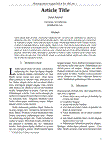| Sumario: | Growth is a factor of prime importance in aquaculture. A better understanding of growthcould result in significant benefits in terms of productivity, sustainability and profitability for aquacultureoperations, provided this greater understanding is translated into relevant and simple applications. The useof growth models, for example, offers an objective and practical way of describing pattern of growth andpredicting production. Growth involves the accretion of body components. The amounts of bodycomponents deposited and the cost of depositing these components are the main factors determining feedrequirement and waste outputs of fish, shrimp and other aquatic animals. This paper examines growth andnutrients deposition and utilization of fish and, to some extent, shrimp under aquaculture conditions.Simple approaches or models for describing and predicting growth, body composition, and feed requirementof fish and shrimp under aquaculture conditions are presented.
|
|---|
